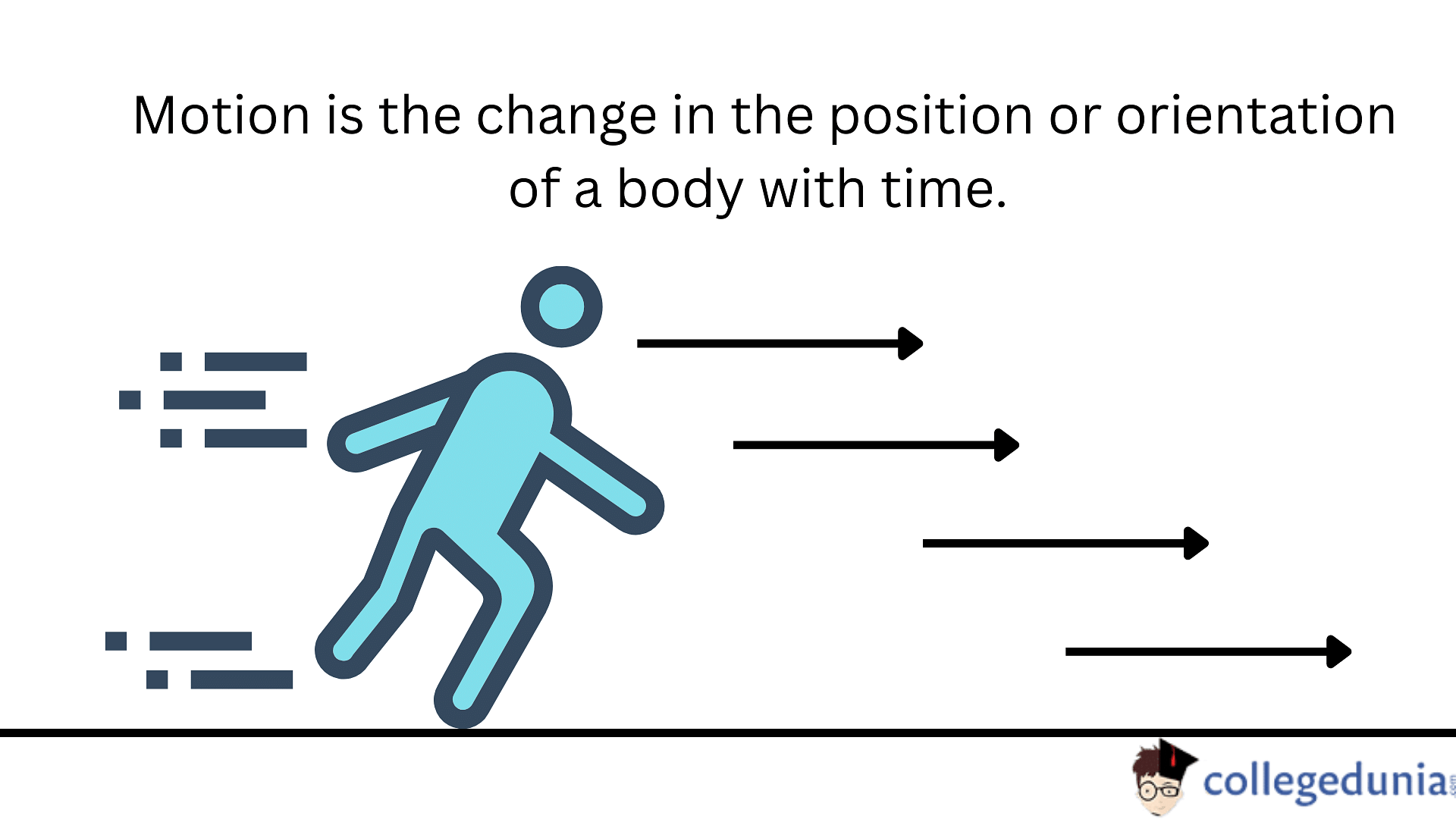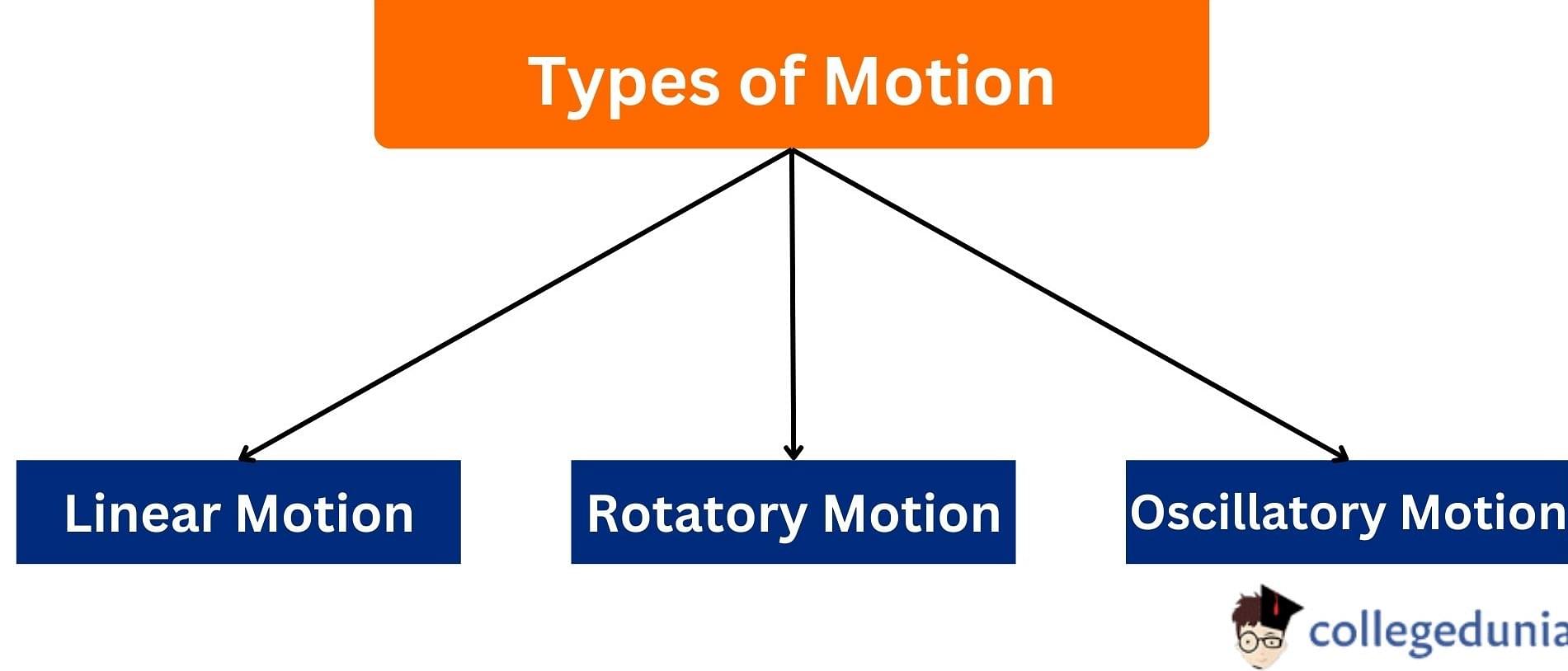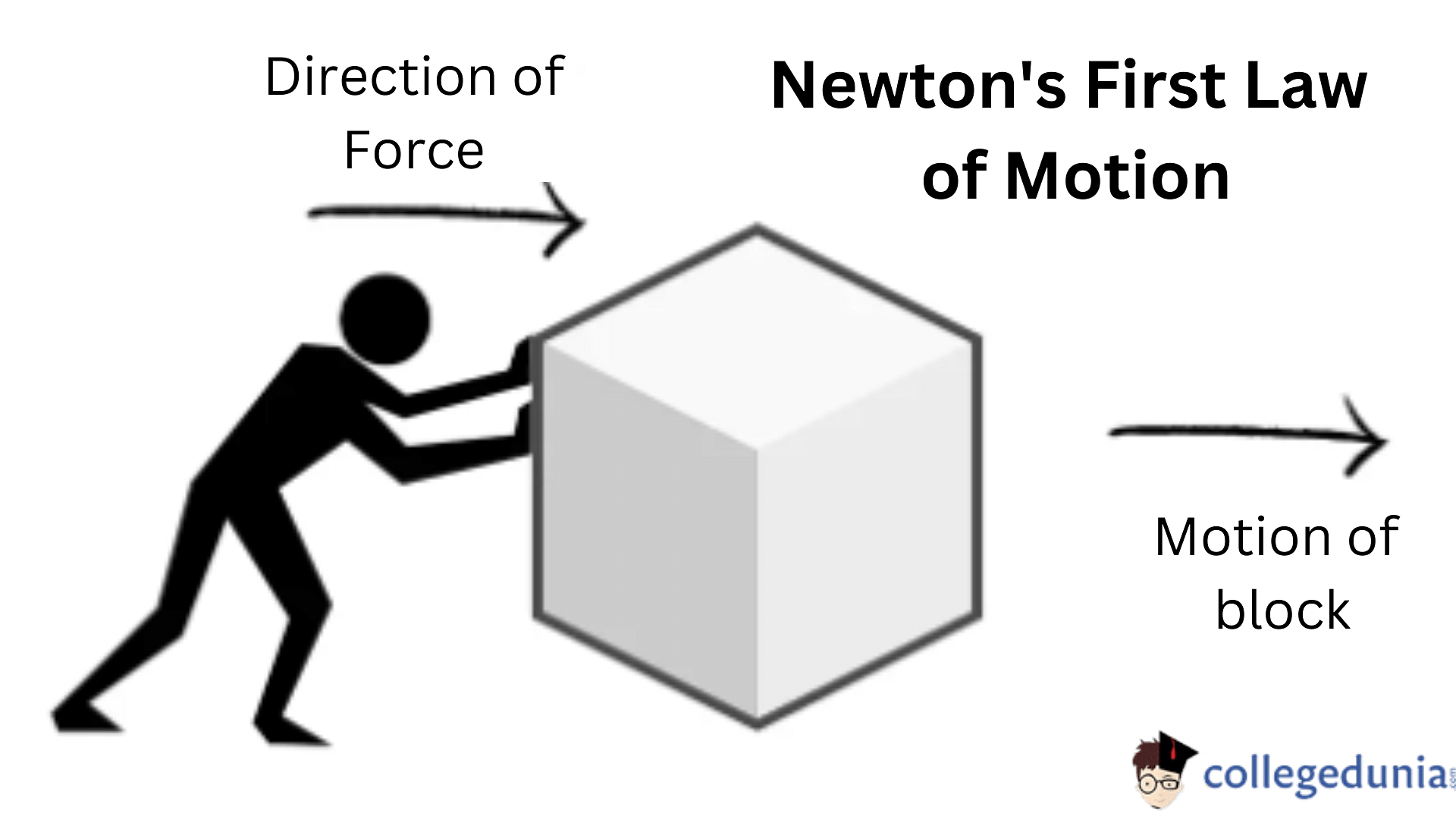Jasmine Grover Content Strategy Manager
Content Strategy Manager
Motion of a body can be referred to as its change in position depending on its surroundings in a given time interval. Motion, in physics, for any object which has some mass can be measured in distance, displacement, speed, velocity, acceleration, and time. The motion of a body can either be uniform or non-uniform on the basis of its velocity. The speed of the body in motion can be referred to as the distance it has traveled per unit of time and velocity is measured as the displacement per unit of time.
- Motion along a line or a curve is referred to as translation.
- Motion that changes a body’s orientation is known as rotation.
- All types of motions are relative to a frame of reference.
- When we say that a body is at rest, it merely means that it is described with respect to a frame of reference that is moving along with the body.
Read More: Derivation of Equation of Motion in Physics
Key Terms: Motion, Speed, Velocity, Acceleration, Distance, Displacement, Uniform, Non-uniform, Laws of Motion in Physics
What is Motion?
[Click Here for Sample Questions]
Motion can be defined as a change in a body’s position in accordance with time. One can easily understand motion with the examples of the cars in the race.
- Let’s say we have 2 cars – car A and car B that are simultaneously running in a race.
- Both cars are in high-speed motion concerning the audience but car A is at rest with respect to car B and vice versa as both are running at the same speed.
- Motion can be fast or slow but every physical body goes through motion.
-
Everything in the universe is in continual motion.
A body on Earth may appear to be at rest because the observer’s position is also on the surface of the Earth. The Earth along with the body and the observer moves in its orbit around the Sun and rotates on its own axis at all times.

Motion Definition
Motion can be expressed and explained through the following different forms:
- Distance
- Speed
- Displacement
- Time
Distance and displacement are both used to describe the change in position. Displacement is the shortest distance between the two points that has a particular direction.
The video below explains this:
Simple Harmonic Motion Detailed Video Explanation:
Also Read: Horizontal Motion in Physics
Examples of Motion
[Click Here for Previous Year Questions]
Some of the day-to-day motion examples are –
- Daily activities such as walking, closing doors, running, etc.
- Air flowing in and out of the lungs.
- Automobile vehicles commuting passengers from one stop to another.
- Daily activities like, walking, running, or jumping.
- Throwing a ball
Types of Motion in Physics
[Click Here for Sample Questions]
Motion is broadly classified into the following four types:
Linear Motion
Particles move from one point to another in a straight line or a curved path in linear motion. On the basis of the path, the motion can be classified as follows –
- Rectilinear Motion – Motion in a straight line.
- Curvilinear Motion – Motion in a curved path.
- Examples of linear motion – the motion of the train, the motion of a car on the road, etc.
Rotatory Motion
The motion when a body rotates on its own axis is known as rotatory motion.
Rotatory motion examples –
- The motion of the earth around the sun about its own axis
- The motion of wheels on their own axis
Oscillatory Motion
The motion of a body about its mean position is known as oscillatory motion. A few examples of oscillatory motion are
- A swing moves to and fro about its mean position.
- The pendulum of a clock oscillates as it moves to and fro about its mean position.
- The string of the guitar moves to and fro when strummed by its mean position resulting in an oscillatory motion.

Types of Motion in Physics
Some other classifications of types of motion include:
- Translational Motion: Motion where a body moves in a path in any of the three dimensions. Example: A person walking on the road.
- Periodic Motion: Periodic motion is a motion that repeats itself. It can be represented in waves.
- Simple Harmonic Motion: SHM is the motion of a body when a restoring torque is acting upon it in a direction opposite to its motion. The acting restoring force is directly proportional to the displacement of the object from the mean position. Example: A moving pendulum
- Projectile Motion: Projectile motion is motion when an object moves in both horizontal and vertical directions. Example: A ball is thrown on a cricket ground
Also Check Out:
| Important Topics Related to Motion in Physics | ||
|---|---|---|
| Distance and Displacement | Motion in a Straight Line | Uniform Circular Motion |
| Type of Motion Measurement | Laws of Motion MCQs | Wave Motion |
| Oscillations MCQs | Rectilinear Motion of Particles | Study Notes on Laws of Motion |
Laws of Motion in Physics
[Click Here for Previous Year Questions]
Newton’s famous laws of motion cannot be neglected coming to the theory of motion. These laws of motion are the building blocks of classical mechanics. There are three established laws of motion given by Newton which are valid everywhere.
First Law of Motion
The first law of motion states that “A body continues to be in the state of rest or of uniform motion unless an external force is applied to it”.

First Law of Motion Illustration
First Law of Motion Examples
- When the bus driver suddenly applies brakes on the bus, the passengers feel a momentary forward pull.
- A book on a bookshelf stays in a state of rest until an external force is applied to move it.
- A marathon runner finds it difficult to abruptly stop himself even after the finish line
- A ball rolling on a plane surface continues in a state of motion unless an external force acts on it. Friction from the surface in most cases makes the ball stop gradually.
Second Law of Motion
The second law of motion states that “Greater the mass of the body, greater will be the force required to accelerate it”. Force is directly proportional to mass and acceleration. The formula derived from this law is:
F = m x a
- F- Force applied
- m- Body mass
- a- Acceleration

Second Law of Motion Illustration
Second Law of Motion Examples
- The speed with which the rocket should move to put itself into the orbit
- Acceleration by a free-falling stone
- Movement of planets around the sun
- Pushing the shopping cart in a supermarket
- Force applied by the golfer to move the ball into the hole plots
- Force needed to push a cart to transport the load on it
The Third Law of Motion
The third law of motion states that “To every action, there is an equal but opposite reaction.”

Third Law of Motion Illustration
Third Law of Motion Examples
- The movement of rockets in the forward direction is due to the release of gases backward at high velocities
- Helicopters lift up by pushing the air below in the downward direction
- The swimmer pushes her feet back against the wall to be able to move (accelerate) in the forward direction
- A person walking on the ground
- An air-filled balloon moves upwards when the air inside it is released in the downward direction
Also Read: Laws of Motion Important Questions
Equations of Motion in PhysicsAfter motion definition, three equations of motion are widely used. Derivation of these equations is a part of kinematics, but the major equations are mentioned below: First Equation of Motion: v = u + at Second Equation of Motion: s = ut + ½ at² Third Equation of Motion: v² = u²+ 2as Where,
|
Things to Remember
[Click Here for Sample Questions]
- Motion Definition – Change in position of the body with time.
- The body is not moving with respect to time is known as the state of rest.
- Rotational, Linear, Translational, Oscillatory, Periodic, and Simple Harmonic are the different types of motion.
- The total path covered by an object is distance and the shortest path covered while in motion is displacement.
- The laws of Motion in physics are important governing factors in physics and there are three laws.
- Speed = Distance/Time.
- Velocity = Displacement/ Time.
- Acceleration= Change in speed/Time.
Check Out:
Previous Year Questions
- What is the change in magnetic field of a charged particle which enters a uniform magnetic field? [JKCET 2006]
- Identify the correct scenario for three objects thrown in the air. [JKCET 2007]
- An example for inertial frame observer is? [JKCET 2009]
- Calculate the time needed by the body to cover ¼ th of the distance from a state of rest? [JIPMER 1999]
- Calculate the reading the spring balance when a mass of 5kg is suspended on an inclined plane? [BITSAT 2006]
- Calculate the impulse experienced by the body which hits a rigid wall? [BITSAT 2018]
- What is the apparent weight of the man moving up the elevator? [DUET 2003]
- What is the work done by the inextensible spring? [BITSAT 2013]
- How much time would the man take to move up the elevator? [NEET 2006]
- What is the minimum stopping distance of the automobile? [KEAM 2003]
Sample Questions
Ques 1. What is the unit of acceleration? (1 mark)
Ans. The unit of acceleration is m/s2.
Ques 2. Suppose a body gains a velocity of 20m/s in 5 sec. Find its acceleration. (2 marks)
Ans. Initial Velocity = 0
Final Velocity = 20 m/s
Time= 5 sec
So, acceleration = (Final vel – Initial vel)/ time
=(20-0)/5
=4 m/s2
Ques 3. Suppose a body decelerates at 8m/s2 and finally gets to rest after 10 sec. Find its starting speed. (1 mark)
Ans. Acceleration = -8m/s²
so, 8 = (initial vel - final vel)/ time
8 = (u-0)/10
u = 80 m/s
Ques 4. Can a moving body have a relative velocity of zero with respect to another body? Give an example. Can a moving body have a relative velocity of zero with respect to another body? Give an example. (1 mark)
Ans. Yes.
Example: When two trains move in the same direction with similar velocity on two parallel tracks the moving train has a relative velocity of zero with respect to another train.
Ques 5. In which frame of reference is the body always at rest? (1 mark)
Ans. In the inertial frame of reference, the body is always at rest.
Ques 6. Distinguish between one, two, and three-dimensional motion. (3 marks)
Ans. The motion of a body along a horizontal line in a definite direction is known as one-dimensional motion.
A body in motion in a plane is known as a two-dimensional motion.
A body in motion in space is known as a three-dimensional motion.
Ques 7. State whether the following two graphs in Fig. here represent the same type of motion or not. Name the motion of the particle. (1 mark)
Ans. Yes both the graphs shown above represent the same type of motion.

The particles shown in the graph have non-uniform motion which means that there is a variable velocity in the moving particles.
Ques 8. Which motion is exactly represented by Δs = vΔt? (1 mark)
Ans. Δs = vΔt represents the uniform velocity.
Ques 9. How many-dimensional motion does the following have? (2 marks)
(a) Train moving fast on its track.
(b) A lizard moving on a wall in a room.
(c) A kite flying in the sky.
(d) Bee flying in a closed room.
Ans. (a) One-dimensional motion.
(b) Two-dimensional motion.
(c) Three-dimensional motion.
(d) Three-dimensional motion.
Ques 10. Explain four types of motion. (4 marks)
Ans. Four types of motion are:
- Rotational Motion: Rotational motion can be understood as a body that is moving in a circular motion around a fixed axis. Example: A rope that tied stone at its end and is being moved
- Linear Motion: Linear Motion is a special type of translational motion that moves in a path but in a single direction and single dimension. Example: A person walking on the road
- Periodic Motion: Periodic motion is nothing but a motion that repeats itself. It can be represented in waves.
- Simple Harmonic Motion: SHM is nothing but the motion of a body when a restoring torque is acting upon it in a direction opposite to its motion. The acting restoring force is directly proportional to the displacement of the object from the mean position.
Do Check Out:






Comments